

Canon EF 8-15/4L USM Fisheye Review
.jpg)
The Canon EF 8-15/4L USM fisheye zoom has replaced the EF 15/2.8 fisheye in the Canon lens lineup. The obvious difference is that one is a zoom and one is a fixed focal length prime lens, but in the case of a fisheye there's a little more to the zoom factor than just a difference in focal length.
Why Fisheye
Fisheye lenses bend straight lines that don't run through (or point towards) the center of the field of view. Why would you want a lens that does this? The answer is that it's the only way to get a really wide field of view. Most of the lenses we use are rectilinear, which means that they reproduce straight lines as straight lines. However for various optical reasons their field of view is limited to something like 120 degrees (diagonal), while a fisheye lens can cover 180 degrees diagonal, and in fact 180 degrees horizontal and vertical as well. While the "distortion" makes the image look odd, rectilinear lenses also distort by stretching objects near the edges of the frame. The wider the lens, the more such objects are stretched. The fisheye just gives a different type of distortion.
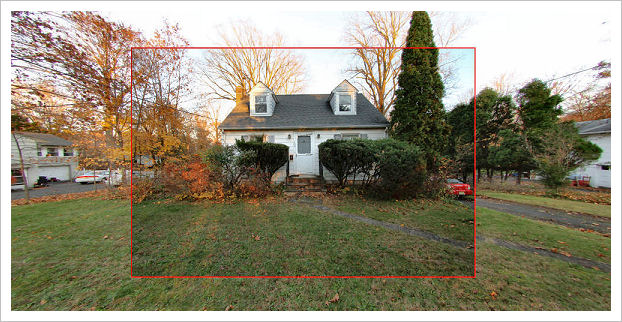
Above is a composite image. The center section outlined in red is the shot as taken with a Canon EF-S 10-22 lens at 10mm on an EOS 7D. The whole image is a rectilinear conversion (see below) of a shot taken from the same location using a Canon EF 8-15/4L at 10mm on an EOS 7D. You can see how much more the fisheye sees, as well as the stretching of edge detail you would get with an ultrawide rectilinear lens.
For more technical information on fisheye lenses, field of view and lens mapping, see my article on Fisheye and Rectilinear Lenses
Fisheye images (or at least 180 degree diagonal fisheye images) can be "remapped" into the same as would be produced by an extreme wideangle rectilinear lens, though image quality at the edges of the remapped image drops since pixels have to be interpolated in the stretched regions. The image below shows a 180 degree fisheye image and its rectilinear conversion:

Note that the current version of Canon's DPP RAW conversion software has the capability of fisheye to rectilinear conversion, however it requires that the images be shot with a recent camera. The EOS 7D and EOS 5D MkII are supported, but the original EOS 5D is not. Most advanced image editors also have the capability for conversions of this type.
Circular Fisheye
There are two major types of fisheye lens. The fist is known as a circular fisheye and it produces a circular image in the center of the frame in which any diagonal of the circular image represents a 180 degree angle of view. This means that the lens has hemispherical coverage. If you lay the camera on its back, the image will contain the whole sky, plus the horizon all the way around as in shown below in an image of the entire night sky.
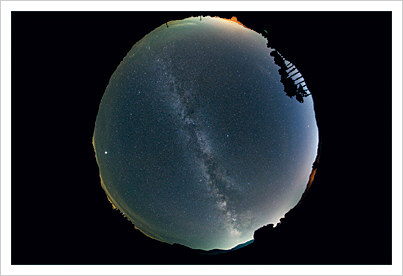
© Canon USA Inc
Full Frame Fisheye
The second type of fisheye is usually known as a full frame fisheye, but in this context "full frame" doesn't refer to a frame the size of a 35mm negative. Instead of "full frame" it could equally well be called a "complete frame" fisheye because it fill the entire frame with a fisheye image and the diagonal of the frame represents a 180 degree angle of view. This is the widest possible field of view that results in the image filling the frame. Any wider and the corners of the image will be dark.
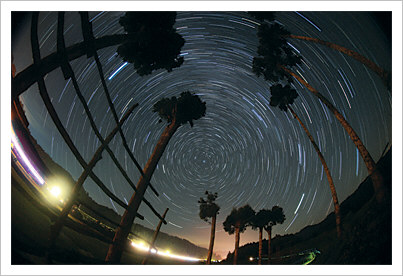
© Canon USA Inc
For a full frame camera (i.e. one with an image size of 36mm x 24mm), the focal length required to produce a circular image is around 8mm, and that required to produce a full frame image with a 180 degree diagonal filed of view is around 15mm. So now you see why the Canon 8-15/4L USM goes from 8mm to 15mm. At one end of the range it's a circular fisheye, at the other it's a full frame fisheye.
What About crop sensor cameras?
That's fine for 1Ds and 5D series EOS bodies, but what what about crop sensor cameras? Canon have two different crop sensor sizes. One is the common APS-C size which is found on all EOS bodies other than the 1D/1Ds and 5D series. The other is the APS-H sensor which is found on the 1D series bodies. What happens to the image when the EF 8-15/4L is mounted on them. Well, that's shown in the figure below:
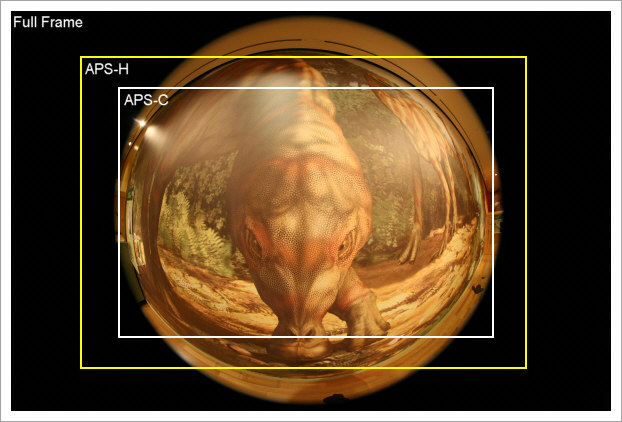
On an EOS 1Ds or 5D series camera, you get the full circular image with black sides as shown the the area labeled "full frame" (where "full frame" refers to a full 35mm sized frame). On an APS-H sensor camera the frame will only contain the area outlined in yellow. You still get an image with 180 degrees coverage in the horizontal direction, but the sides are black and part of the top and bottom of the circular image are cropped out. This is the same situation as for the APS-C frame (shown in white), except now the image fills the frame horizontally but the corners are dark.
The upshot of this is that the EF 8-15/5L USM can only produce a true 180 degree coverage circular image when used on a full frame camera from the EOS 1Ds or EOS 5D series.
While crop sensor cameras can't record a circular fisheye image, they can record a "compete frame" 180 degree diagonal image by zooming out a little. For an APS-C sensor, such an image is formed at a focal length setting of 10mm. In fact the lens has a stop which can be set which limits the zoom range to 10-15mm so that if you are shooting with an APS-C crop sensor camera, zooming out all the way gives you a 180 degree diagonal coverage image with no dark corners. With an APS-H sensor camera, a setting of 12mm produces a 180 degree diagonal image with no vignetting.
The hood and its issues
If you think about it, it's obvious that you can't use a lens hood on a lens with a 180 degree circular field of view. The lens images everything that's in front of it, and that would include any lens hood! The hood supplied with the EF 8-15/4L can only be used without it entering into the field of view at 15mm with a full frame camera. With an APS-C camera it can be used between 10mm and 15mm and with an APS-H sensor camera it can be used between 12mm and 15mm.
Because the front element of the lens protrudes, the lens cap attaches to the hood and can only be used when the hood is attached. The lens cap itself is actually "dish" shaped rather than flat and slides over the hood. The hood+lens cap can be removed and replaced as a single unit to protect the lens when not actually shooting.
For the same reasons you can't use a flat lens cap, you can't mount a front filter either. It would contact the front element and it would get in the wideangle shots. There is a rear mount for up to three gel filters, though if you are shooting digital, color correcting filters aren't really needed. Perhaps a ND filter might be occasionally useful. There's no practical way to use a polarizer, though you probably would not want to with such a wideangle lens (the sky is not uniformly polarized across wide angles, so polarized wideangle skies are uneven).
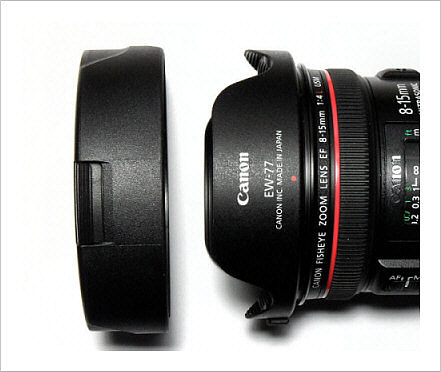
The Canon EF 8-15/4L USM Image Quality
A problem often found with inexpensive fisheye lenses is that as you approach the edges of the image, the image quality significantly decreases with lowered sharpness and increasing levels of chromatic aberration. However this is certainly NOT the case with the Canon EF 8-15/4L USM. Even wide open at f4 image quality is good all the way out to the edge of the image, even when the edge of the image is in fact the edge of the image circle as is the case with the circular images. An example is shown below:
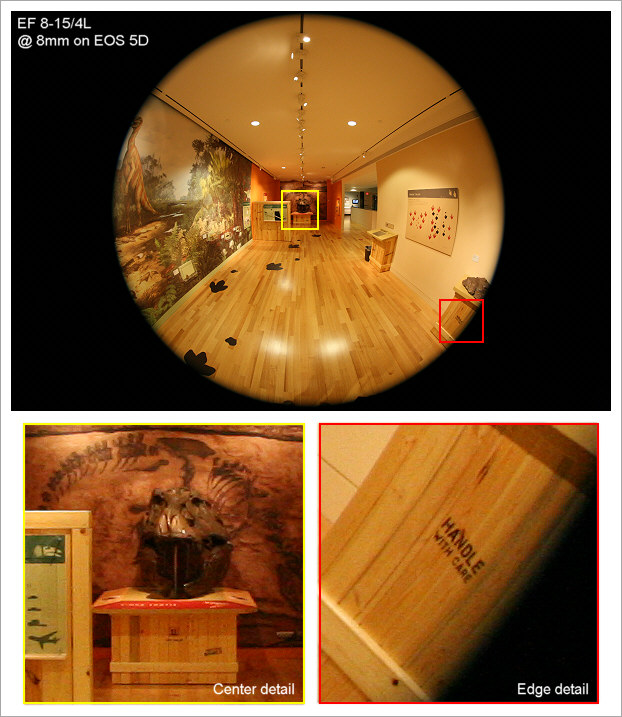
The top image is the whole image as recorded using an EOS 5D body @ ISO 1600 and an exposure of 1/60s at f4. The crops at the lower left and right are 100% crops from the original image, from the center at the left and from the edge of the image circle at the right. As you can see, even at the edge of the image circle and viewing at 100%, the image is still sharp and shows little visible chromatic aberration. Stopped down the image does sharpen up slightly but I'd have no hesitation in shooting this lens wide open.
A similar story is found at other focal lengths, with edge and corner quality maintained even with the lens at f4. Very good performance from a fisheye lens and certainly worthy of the Canon "L" designation.
The Canon EF 8-15/4L USM does not have any optical stabilization. There are probably two reasons for this. First, it really doesn't need any. You can hand hold the lens and get sharp images with shutter speeds of 1/8s or slower. Second, given the complexity of the design, it would have been tricky to add IS without compromising image quality and increasing the size, weight and cost of the lens. This is one case where IS wouldn't really add much to - and might even take something away from - the lens.
Who is it for
This is a lens ideally suited to someone who owns a full frame EOS DSLR (1Ds or 5D series) and who needs a high quality fisheye lens. On a full frame camera it does double duty as both a 180 degree circular and a 180 degree diagonal lens. Owners of crop sensor cameras won't get quite so much utility out of the lens since they won't be able to record the full 180 degree circular image, though the lens will still provide excellent 180 degree diagonal image quality as well as acting as a fisheye zoom.
Canon did have an EF 15/2.8 fisheye (non-L), but it now seems to have been discontinued. There are fixed focal length fisheye lenses from 3rd party manufacturers available however. Some are manual focus and some are designed only for crop sensor cameras. I'm not aware of any full circular 180 degree fisheye lenses for crop sensor cameras, though 180 degree fisheye lenses for the APS-C format are available (nominally with focal lengths in the 8-10mm range)
Canon EF 8-15/4L USM Fisheye Zoom - Specifications
| Focal Length | 8 – 15 mm |
| Aperture | Maximum: f/4; Minimum: f/22 |
| Camera Mount Type | Canon EF |
| Format Compatibility | 35mm Film; Full-Frame Digital Sensor; APS-C; APS-H |
| Angle of View | 180° circular to 180° diagonal (on full frame) |
| Minimum Focus Distance | 6.2" (15.75 cm) |
| Magnification | 0.39x [1:2.56] |
| Groups/Elements | 11/14 |
| Diaphragm Blades | 7 |
| Filter | Rear mounted gel |
| Image Stabilization | None |
| Autofocus | Yes |
| Tripod Collar | None |
| Dimensions (DxL) | 3.1 × 3.7" (7.87 × 9.40 cm) |
| Weight | 1.19 lb (540 g) |
